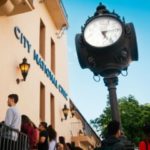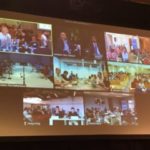When Barcelona hosted the International Union for Conservation of Nature (IUCN) World Conservation Congress in 2008, a group of passionate delegates from Hawaii sat up in their chairs and thought, Why not us?
Why not, indeed? Hawaii possesses the highest concentration of endangered plants and animals in the United States — and one of the highest in the world — along with fascinating indigenous challenges for case studies. No matter that a single state had never hosted the event, only entire countries. Or that the remote island with strict U.S. visa policies was a long shot in every sense for the Eurocentric IUCN, whose attendees would be converging from 170 countries.
There’s some, how do I say, some destiny at work here
Fast-forward eight years and two bids. This month, the Aloha State will host World Conservation Congress (WCC) 2016 and its estimated 10,000 attendees — representing not only the first time the group meets in the United States in its 68-year history, but the largest conservation event ever to be hosted by a U.S. destination. Significantly, this is also the centennial year of the U.S. National Park Service, two of whose inaugural locations are in Hawaii. And while Hawaiian environmental advocates call the state’s selection to host WCC 2016 a dream come true, the logistics required to pull it off in this age of heightened demands and expectations could also be called a worrywart’s nightmare.
“It’ll be a hard ride up until then, with all the issues of logistics and politics and communication and public safety,” said Randall Tanaka, executive director of the WCC National Host Committee in Hawaii, speaking to Convene in July. “There were so many times we should have been kicked off the field. But there’s some, how do I say, some destiny at work here.”
THE OLYMPICS OF CONSERVATION
Held once every four years, WCC is an esteemed meet-up of stakeholders in the world of conservation: scientists and academics, politicians and policy makers, educators, NGOs, business interests, environment and climate experts, and indigenous groups. When the program was formed in 1948, the idea was to create discussions leading to solutions for a diverse range of environmental problems. “In order to make a difference on conservation issues, it is necessary not only to have the participation of governments, but also of civil society,” said Enrique Lahmann, global director of the union development group and director of WCC for Switzerland-headquartered IUCN. “IUCN was mostly academic in the beginning, but after 40-plus years, the members came to realize that in order to make a difference in conservation, it was necessary to open doors a bit and listen to the experience of other sectors of society.”
Sometimes referred to as “the Olympics of conservation,” WCC enables world leaders to put their heads together on critical issues of the day, ranging from mosquito-borne viruses and species extinction to photovoltaic technology and nature-based solutions to human-rights abuses. For this year’s program, held at the Hawaii Convention Center (HCC) in Honolulu on Sept. 1–10, more than 1,300 sessions will include workshops, dialogues, roundtable discussions, training courses, music performances, and exhibitions, as well as a Members’ Assembly that will vote on IUCN resolutions and recommendations regarding key conservation issues.
As with the actual Olympics, WCC’s prestigious assets come with complications. Chief among them: The event calls for the U.S. State Department to issue an unprecedented number of visas, some for citizens of countries with strained relations with the United States. But in economic impact alone, the headaches are worth it: WCC delegates are expected to generate an estimated $45 million in visitor spending and another $6 million to $8 million in tax collections, according to Tanaka. And while this isn’t the largest event Hawaii has hosted — the 2011 Asia-Pacific Economic Cooperation (APEC) forum brought 17,000 delegates, and the 2015 Lions Club International Convention more than 20,000 — WCC 2016 is a longer program, and is expected to have broader social and economic impact, as well as public involvement and education.
“We can measure visitor spending, but the value added is what comes out of the congress,” Tanaka said. “It is the exchange of ideas and building the network of cohorts who improve the human condition.”

LET THE BIDDING BEGIN
After inspiration struck in 2008, Hawaii took a run at bidding on WCC 2012. But the fledgling host committee wasn’t prepared for some of the requirements and hurdles: a complex funding package, an appreciation of complicated IUCN process and protocols, and lackluster federal support. But when the 2016 bid came around, the state was better prepared; the finalists were winnowed down to Hawaii and Turkey, the latter of which had the advantage of being geographically much closer for the majority of attendees.
The million-dollar question (actually, the $22-million question) is one worthy of a business-school case study: How did Hawaii go from “disorganized” in its first bid, according to Tanaka, to “amazing” in the estimation of Lahmann, who as WCC’s director heads the destination-selection process? “First and foremost, the people made a big difference, and for us really a sense of their true interest in hosting the congress,” Lahmann said. “It’s not a situation where they just wanted any major event to come to Hawaii — there was a legitimate interest. It was a grassroots effort of many parties — members of the IUCN, members of the [host] commission, members who knew of the long history of work in conservation.”
The HCC was also a factor in IUCN’s decision, especially because it can accommodate the entire WCC program. “In previous years we’ve had to go to some outside venues, and that increased the logistical challenges,” Lahmann said. “Here, everything was able to be contained. This will be the largest environmental congress taking place ever in the U.S. And we felt that it was time to have it here.”
Lessons learned from hosting APEC also helped Hawaii clinch the congress. That experience created a body of carryover knowledge in a variety of complex areas: heightened security and sensitivity to protocol, with 21 world leaders participating in APEC; road-tested technology capabilities at the HCC; translators and interpreters who had been required for attendees from nations as far-flung as Australia, Russia, Mexico, Thailand, and Papua New Guinea; and a heightened focus on business, investment, and innovation, for an island better known for its unique natural resources than its economic culture. “All the institutional knowledge coming out of APEC — from approaching neighborhood boards and neighboring islands, to road and canal closings — helps us perform this congress,” Tanaka said.
Every congress is unique in itself, with different challenges.
But even with APEC under its belt, Hawaii was no shoo-in. The host committee needed national support, and initially received an unenthusiastic response from the U.S. government. “From a policy and political standpoint,” Tanaka said, “we weren’t able to sign on to some of the protocol and global policy issues that get everyone together on the same page regarding the environment.”
It took a little convincing with the U.S. Department of State, and Tanaka found an ally in Daniel Inouye, the late U.S. senator from Hawaii. A letter of support from President Obama didn’t hurt, either. “The United States would be honored to host the World Conservation Congress for the first time in the over-60-year history of the IUCN,” Obama wrote. “As someone who grew up in Hawaii, I know the warmth and hospitality of the Hawaiian people will make a lasting impression on the delegates to the Congress.”
Tanaka credits the successful bid to persistence. “We kept plowing away at it,” he said. “If there’s anything I’ve learned in this game, it’s that you don’t really lose — you just have to pick another time to get the win. Because it repeats itself. Opportunities come back around.”
THE CHALLENGES OF WCC 2016
“Every congress is unique in itself, with different challenges,” Lahmann said. “For example, Korea was an excellent host [for WCC 2012], and we felt very welcome. But they learned a lot more about IUCN and the fact that this was the World Conservation Congress, not the Korea congress that IUCN helped them put together. Reaching that balance was our challenge there — on one hand, incorporating the interests on the local level while making sure there’s room for all the other countries to have meaningful participation.”
Among the challenges that the host committee and IUCN have recognized for WCC 2016:
FUNDING: ‘This is an expensive congress’
As early as its 2012 bid, Hawaii realized funding was going to be a hard sell. WCC comes with a $22-million price tag, half of which would be carried by the state of Hawaii — a tough pill to swallow, but easier for the 2016 bid after it had been already broached in 2012. “This is an expensive congress,” Tanaka said, “and people don’t like funding or subsidizing congresses.”
One reason for the high cost is the sponsoring of delegates from countries that can’t afford to send representatives. “And yet those are the countries that most need to engage and get involved,” Tanaka said, “to create a network of cohorts and peers to advise them in their conservation issues.” A $500,000 award from the Office of Hawaiian Affairs — an independent state agency, and one of 94 U.S.-based IUCN members — was particularly helpful in underwriting key features of WCC 2016, including expanded opening and closing ceremonies, the promotion of Native Hawaiian cultural sites across the state to all registered participants, and programming throughout the event.
VISAS: ‘A lot you have to go through’
From the outset, organizers knew that securing visas would represent a hardship for some attendees. “There’s a lot you have to go through to get into the U.S.,” Tanaka said. “The Department of State and the folks that work in the embassies around the world are the first line of defense, and they do an outstanding job. If you don’t start early, it’s going to be difficult.”
The host committee has provided help with visa facilitation, has given advance notice to international embassies, and has a contact in Washington, D.C., lined up in case of a snag. “I think our process is about as robust as it can be given the heightened security going on now,” Tanaka said. “If you’re a bad guy trying to get into the U.S., the visa process is an outstandingly tough one.”
If you’re a talented young professional, the visa process can be equally tough for another reason altogether: to keep out someone who might be intending to stay past the limits of the visa. “There have been some rejections of visas in some cases,” Lahmann said, “and we are understanding and respectful of the legislation in the U.S., but sometimes that has posed a bit of a challenge for us.”
GREENING: ‘Walk the talk’
Staging a conference that prioritizes recycling, reuse, and conservation seems like a no-brainer for an environmental group. But in practice, it’s anything but. WCC has had green initiatives in place for years, but in Hawaii, it wants to go a step further. “The technology is there to enable us to do it, so we want to walk the talk,” Lahmann said. “We promote conservation and use of natural resources, so we have to preach by example. After the congress, we’ll see which areas were successful and which need to be improved for next time.”
IUCN is aiming to make WCC 2016 its greenest congress yet, with ambitious initiatives for sustainable practices. For starters, it’s going to be plastic-free — no plastic bottles will be sold at the HCC; water fountains and reusable water bottles will be encouraged. As part of IUCN’s Green Hotels Initiative, participating WCC hotels are designated with one to three green hibiscus icons, which show delegates their rating for steps taken toward eco-friendly operational practices, such as reducing energy consumption, installing low-flow plumbing, and recycling waste. Group transportation will be largely nonexistent; if you’re within 20 minutes of the HCC, you walk. Food will be locally sourced as much as possible. And the program will be almost entirely paperless, using a mobile app instead of a printed schedule, and providing almost all convention materials online rather than offering hard copies.
“Paperless is very difficult, but we can do this because the technology is there,” Lahmann said. “That was one of the reasons the Hawaii Convention Center was selected, because it has very good internet and Wi-Fi. They’ve already been bombarded with APEC, and were able to withstand the test.”
LANGUAGE: ‘A totally different meaning’
WCC has three official languages: English, French, and Spanish. That presents enough of a challenge for any destination when 170 countries are represented, but that Eurocentric focus is particularly formidable for Hawaii. “If you told me you needed Japanese, Chinese, and Korean, we have those resources easily in Hawaii,” Tanaka said. “So we’re importing that talent, and using our universities.”
For its 18 concurrent workshops, the WCC has coordinated a team of 38 interpreters — six teams of six members, with two for each official language per team, plus chief interpreters to oversee the teams. Mere translation isn’t enough for WCC. Interpretation provides greater depth, with language specialists able to understand not only the nuances of each native tongue but the technical complexities of conservation.
“Translation is verbatim,” Tanaka said. “Interpreters need to be licensed to interpret what an individual is saying, which could be a totally different meaning.” And that meaning can change each time one of the three official languages changes its wording. “We have to be extra-careful to make sure that whatever is written in Spanish has the same meaning in French and English,” Tanaka said. “And if we find a better way to express something in Spanish, then we must go back and find a different way, a better way, to say the same thing in English and then French.”
LOCAL VS. GLOBAL INTERESTS: ‘All these stories’
Hawaii’s preeminent status as a center of biodiversity was certainly a boon in landing WCC 2016. There’s no question that conversations about conservation will be at home in Hawaii. The state is estimated to have lost 115 of all known native plant species, while around 57 percent of them — nearly 700 species — currently face some type of risk. Roughly 90 percent of Hawaii’s native plants are found nowhere else on Earth.
Hawaii also has a seat at the table when it comes to renewable energy, having committed to be petroleum-free by 2025. The state already possesses the highest per-capita production of photovoltaics, which convert light into energy. “The green growth, what we are doing with energy and emissions, and how we export that knowledge and technical expertise to other islands and nations around the world — that becomes the legacy for the state,” Tanaka said, “and the legacy items that will come from this congress for everyone.”
Having so many Hawaiian academics drawn to the location certainly offers the opportunity for a true legacy in timely, critical issues that are specific to the destination — such as controlling the mosquito that’s an imminent threat to certain rare Hawaiian bird species. But what about, say, tiger habitats in Africa? Or sustainable agriculture there? The temptation to reach for specific local case studies and solutions is also a reminder of the importance of making the congress a widespread success in all participants’ eyes. And of understanding how many problems that might seem different on the surface actually have universal relevance.
The area of environmental law is a prime example of this, with its multifaceted concerns, including the spotty enforcement of many conservation statutes, and the appreciation that since contemporary understanding of climate change is constantly evolving, so must its laws. To that end, WCC will for the first time hold a mock trial, involving Hawaii’s Supreme Court, local law students, and top justices from around the world. “It’s unprecedented. Nothing like this has been done before,” said Hawaii Supreme Court Associate Justice Michael D. Wilson, who is coordinating the trial in cooperation with the University of Hawaii Law School as well as justices from Norway, Africa, and Brazil. “The subject matter of the trial has to do with whether future generations should have standing to challenge the climate policies that would be threatening the ecology of the world in the future. It’s a particularly exciting signature activity that allows for the legal community to participate along with law students in an issue on the cutting edge for humanity. Because certainly it’s quite clear that the secretary general of the UN considers this — climate change — to be the leading issue facing humanity.”
It is precisely these sparks of connection, Tanaka says, that are the true value of coming together — the value-added “what and why” that emerge from a global conversation. “It is the exchange of ideas and building the network of cohorts who improve the human condition,” Tanaka said. “There are hundreds and hundreds of stories occurring, professionals and academics sparking solutions. How do we tell all these stories? We can never know them all, and the intangible stuff we’re not counting in the bottom line is of significant value.”




